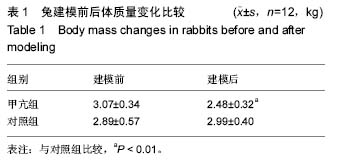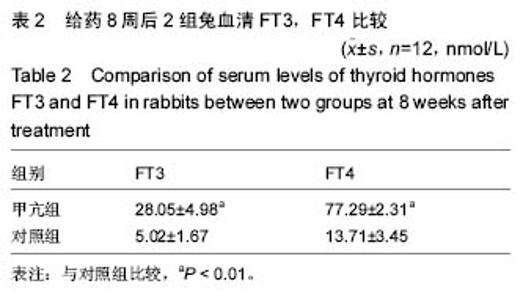| [1] 姒蜜思.骨质疏松与种植体成功率[J].中国实用口腔科杂志,2010,3(1):58-61.
[2] 韩静,江霞.甲状腺疾病与骨质疏松的关系研究进展[J].医学综述,2013,19(20):3694-3696.
[3] 聂莹,张志宏,袁晟,等.糖尿病对大鼠牙槽骨缺损修复中骨形态发生蛋白-2表达影响对研究[J].口腔医学, 2011, 31(1): 26-32.
[4] 周建国,杜一飞.骨质疏松症对大鼠胫骨种植体骨结合的影响[J].口腔生物医学,2012,3(3):135-138.
[5] 李洪亮,司家文,沈国芳,等. 骨代谢过程中雌激素的影响与作用[J]. 中国组织工程研究,2015,19(7):1077-1081.
[6] 吕娇,刘洪臣.糖尿病对种植体骨结合影响对研究进展[J].中华老年口腔医学杂志,2008,6(2):123-126.
[7] 王峰,宋应亮. Ⅱ型糖尿病影响种植体周围骨结合因素的研究进展[J].牙体牙髓牙周病学杂志,2009,19(8): 483-488.
[8] 聂莹,张志宏.糖尿病对种植体周围骨组织对影响[J].国际口腔医学杂志,2010,37(4):451-453.
[9] 张琳琳,张静莹,曲哲,等.还原型谷胱甘肽促进高糖成骨细胞的增值与分化[J].中国组织工程研究,2015,19(7): 985-990.
[10] 张彬,王延雪,孟菲,等.不同直径微种植体支抗即刻负载在甲亢大鼠模型中稳定性的研究[J].中国煤炭工业医学杂志,2011,14(2):250-252.
[11] 李素萍.骨质疏松动物模型的研究现状[J].中国组织工程研究与临床康复,2011,15(20):3767-3770.
[12] 宋凌鲲,宋明宝,王国强,等.成年犬甲亢性心脏病动物模型的建立及鉴定[J].现代医药卫生,2009,29(21):3201-3202
[13] 王亚娟,礼广森,孙艳红,等.定量组织速度成像评价兔甲亢性心肌病模型的建立[J].中国介入影像与治疗学, 2011, 8(5):435-438.
[14] 韩静,江霞.甲状腺疾病与骨质疏松的关系研究进展[J].医学综述,2013,19(20):3694-3696
[15] Somwaru LL,ArnoldAM,Joshi N,et al.High frequency of andfactors associated with thyroidhormoneover- replacement andunder-replacement in men and women aged65 andover.JClin Endocrinol Metab. 2009;94(4): 1342-1345.
[16] Turner MR, Camacho X, Fischer HD, et al. Levothyroxine dose and risk of fractures in older adults: nested case-control study. BMJ.2011;342: d2238.
[17] Mazziotti G, Porcelli T, Patelli I, et al. Serum TSH values and risk of vertebral fractures in euthyroid post-menopausal women with low bone mineral density. Bone.2010;46(3): 747-751.
[18] FlynnRW,BonellieSR,JungRT,etal.Serumthyroid-stimulating hormone concentration and morbidity from cardiovascular disease and fractures in patients on long-term thyroxine therapy. J Clin Endocrinol Metab. 2010; 95(1): 186-193.
[19] Ko YJ, Kim JY, Lee J, et al. Levothyroxine dose and fracture risk according to the osteoporosis status in elderly women.J Prev Med Public Health.2014;47(1): 36-46.
[20] 巴建明,孙启虹.药源性骨质疏松[J].药品评价, 2014, 11(11):22-26.
[21] 张丽丽,傅晓敏,刘敏燕,等. 药源性骨质疏松[J].中国药物应用与监测,2015,12(6):383-386.
[22] 周瑾,李玉姝. Graves 病动物模型及 Graves 病发病机制的研究进展[J].中国免疫学杂志,2010,26(8):758 -763.
[23] Wang Z,Zhang Q,Lu J,et al. Identification of outer membrane porin f protein of Yersinia enterocolitica recognized by antithyrotopin receptor antibodies in Graves ' disease and determination of its epitope using mass spectrometry and bioinformatics tools. J Clin Endocrinol MeTab. 2010;95(8):4012-4020.
[24] Hargreaves CE,Grasso M,Hampe CS,et al. Yersinia ?enterocolitica provides the link between thyroid-stimulating antibodies and their germline counterparts in Graves’disease. J Immunol. 2013; 190(11):5373 -5381.
[25] 刘树民,崔晓旭,陈平平等.两种甲状腺功能亢进症动物模型的对比研究[J].中国比较医学杂志,2014,24(7):19-24.
[26] 赵玲.甲状腺机能常见评价指标及其临床分析[J].中国卫生标准管理,2014,5(7):67-69.
[27] Bianco AC,Mcaninch EA.The role of thyroid hormonend brown adipose tis sue in energy homoeostasis.Lancet Diabet & Endocr. 2013;1(3): 250-258.
[28] Marwaha RK,Tandon N,Ganie MA,et al.Reference range of thyroid function (FT3,FT4and TSH)among Indian adults.Clin Bioche.2013;46(4):341-345.
[29] 鲁彦,岳建云,苑芳,等.化学发光法和放射免疫法检测胰岛 素[J].医学研究杂志,2012,41(7):40-41.
[30] 高莉囡,王海波,吴丹,等.化学发光免疫法检测甲状腺激素 及抗体结果的临床意义[J].吉林医药学院学报, 2013,1: 10-12.
[31] Hubl W ,Meis sner D,Demant T,et al.Evaluation of the LIAISON thyroid chemiluminescence immunoasays. Clin Lab.1999;46(3-4):181-189
[32] 胡蓉.化学发光法检测甲状腺激素的临床应用[J].中国医药导刊, 2012,14(5):877-878.
[33] 李晶,高峰,刘婷.化学发光法检测甲状腺激素的临床应用 [J].河北医药,2013,24:3769-3771.
[34] 邓文松,马巧玲.碱性磷酸酶在甲亢中的临床意义[J].中国医疗前沿,2012, 7(18):58-60.
[35] 宫琳,周延民,李春艳,等.快速建立兔骨质疏松症动物模型的方法[J],吉林大学学报:医学版,2008,34(5):903-906.
[36] 刘梅,张君,王旭霞.糖尿病大鼠牙槽骨骨密度与全身骨密度变化的相关实验研究[J].华西口腔医学杂志,2009, 27(4):451-454.
[37] 王铁梅,林梓桐,葛久禹,等.颌骨骨密度和全身骨密度的相关分析[J].实用口腔医学杂志,2008,24(6):851-854.
[38] Watts NB.Fundamentals and pitfalls of bone densitometry using dual-energy X-ray absorptiometry (DXA).Osteoporosis Int.2004;15:847-854. |







